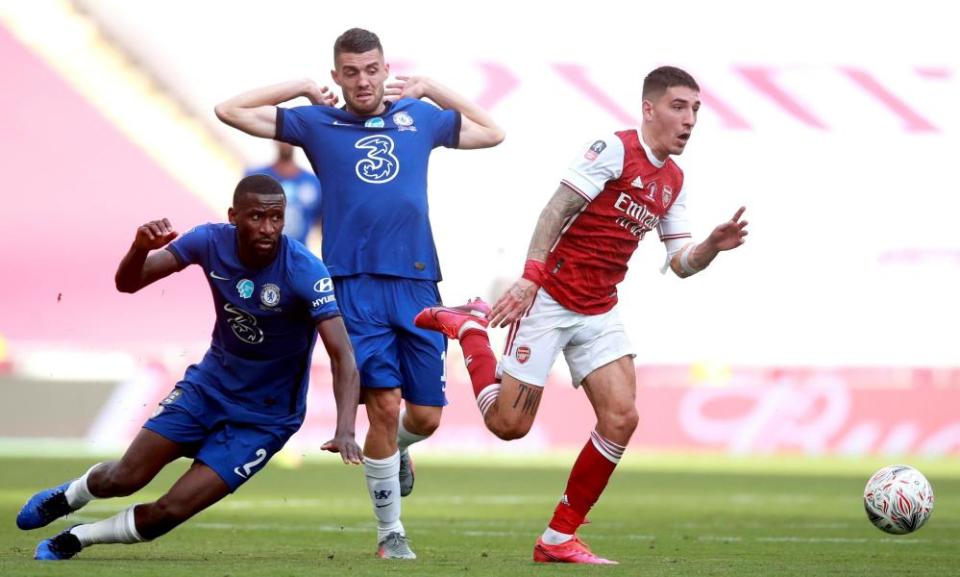Frank Lampard must resolve Chelsea's defensive issues to progress

In July 1971, Apollo 15 approached the Moon. After the lunar module detached bearing the mission’s other two astronauts, Al Worden was left alone in the command module. When he went behind the Moon, breaking transmission with Houston, he entertained himself by playing the Beatles, Elton John and John Denver and the soundtrack to 2001: A Space Odyssey.
Orbiting 2,235 miles from his companions on the Moon’s surface and quarter of a million miles from Earth, Worden was for three days the most isolated human to have existed since Adam. Or at least he was until the 67th minute of the FA Cup final on Saturday.
Related: Azpilicueta's tears symbolic of Chelsea's defence to weep for
When Dani Ceballos tackled Pedro, the ball broke to Héctor Bellerín midway inside his own half. He began to run. About 35 yards away, Antonio Rüdiger looked up. We can’t know his thought processes but presumably he registered that the ball was a third of the length of the pitch away and for a moment thought this couldn’t possibly be his issue, not directly. Given, with Bellerín on the charge, it was already too late to press, his job was to drop back into the defensive structure.
But then there must have been a realisation that this was his responsibility, that there was nobody before him who had a chance of intercepting Bellerín. And that must have been a dreadful moment. Modern attacking is often about the generation of five yards of acceleration space, so that when a player in possession reaches an opponent he is already moving at speed; match a player who is running against a static defender and it takes only the slightest jink to go by him. But Bellerín didn’t have five yards; he’d had 40. In the middle of a modern football pitch, in the middle of the second half, Chelsea’s shape disintegrated to the extent that an opponent had 40 yards in which to run unchallenged.
Rüdiger had two choices. He could have kept dropping with the rest of his defensive line, could have let Bellerín keep running, could have hoped he miscontrolled before a probable encounter somewhere near the edge of the box. Or he could do what he did, and stand, trying to head off the danger before it came too close to goal.
It was probably the right thing to do, but it required somebody else to cover – Marcos Alonso to come inside or Andreas Christensen to move left. Neither did and so, at the moment Bellerín reached Rüdiger, he couldn’t have been more alone if he’d been picking up the rice where a wedding had been. Rüdiger, having no option, made himself as broad as possible and Bellerín nutmegged him.
Related: Pierre-Emerick Aubameyang shows why he is Arsenal's talisman
Christensen hurled himself into a desperate challenge – an obvious red if he’d been fractionally late – and won the ball, but it bounced to Nicolas Pépé and by then all shape was gone. Pierre-Emerick Aubameyang was free on the left. Pépé found him and, although Kurt Zouma got across, he was off-balance and also isolated, an easy mark for Aubameyang’s trickery before a deft finish.
But brilliant as the footwork was, the goal was created by the failing that has dogged Chelsea all season: defensive structure. This is the vast question mark that overshadows everything positive Frank Lampard has done as a manager. No Premier League team conceded more goals to fast breaks than Chelsea. They must be aware of the problem, yet Arsenal again and again created opportunities with simple balls over the top.

Aubameyang kept finding space behind César Azpilicueta. That was what brought the penalty, but it should also have brought a red card and, however unfortunate Mateo Kovacic was to collect a second yellow, the decision not to send off Azpilicueta was worse; it’s at least possible to understand how a clash of legs could be misconstrued, but to think Azpilicueta was making a genuine attempt to play the ball – the fourth official’s reported explanation to Mikel Arteta – is unfathomable.
But that’s not an issue of the defensive line; it’s an issue of organisation. You can only play a high line if the front part of the team is pressing the man with the ball cohesively. Since the first weekend of the season when United picked them apart 4-0, Chelsea have not done that.
When it begins to disintegrate, there’s something very jarring about watching them: the number of times the defending ends up as a one-on-one battle makes it seem like football from the early 1960s, before the coming of systematisation and the widespread adoption of back fours and zonal marking (it’s coincidence, but this was only the second Cup final since 1963 in which neither side played a back four).
Related: Arsenal 2-1 Chelsea: FA Cup final player ratings
The instruction at half-time was presumably for Chelsea’s defensive line to sit a little deeper, not to leave the space behind them. But space doesn’t just disappear. And so in the second half it moved from behind the defensive line to being in front, and the result was the great expanse through which Bellerín was able to surge before finally coming upon Rüdiger, exposed and defenceless like Pincher Martin on his rock.
The future for Chelsea looks exciting. To an already vibrant young squad have been added Timo Werner and Hakim Ziyech, with Kai Havertz and others seeming likely to follow. But all the talent and potential in the world will mean nothing if Lampard can’t get the basic defensive structure right.

